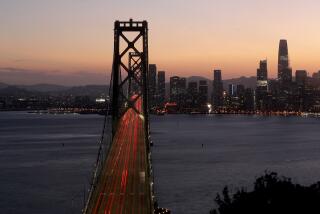California should set interim goal for cutting emissions, report says

California is on track to reach its target for reduced greenhouse gas emissions by 2020, but much tougher choices loom if the state is to meet its goal for the year 2050, state air quality officials say in a new report.
The changes needed to slash emissions enough to reach the mid-century target will be so great that the state should set an interim goal for about 2030, the California Air Resources Board said in a report released Monday.
The state’s 2020 goal for fighting climate change is to scale back greenhouse gas emissions to 1990 levels. The goal for 2050 is to reduce emissions to 80% below 1990 levels.
Reaching that target will require tough new policies to slash carbon emissions in every sector of the economy, including energy, transportation, agriculture and water delivery, the board said.
“We have to accelerate our efforts to become more efficient,” state Air Resources Board Chairwoman Mary Nichols said. “The overarching test of everything we do is its impact on global climate change.”
California will first have to transform its energy sector, which accounts for about half its greenhouse gas emissions, by relying increasingly on wind and solar power, making buildings more efficient and advancing energy storage technology, the report says.
Meeting the goal also will mean changing the transportation system, which contributes about 38% of the state’s greenhouse gas emissions. California will have to boost vehicle efficiency; develop lower-carbon fuels; expand access to public transportation; clean up emissions from freight-carrying trucks, locomotives and ships; and expand access to public transportation, the report says.
The report also called for a strategy to cut other pollutants, including smog-forming compounds, methane and black carbon, which are shorter-lived than carbon dioxide but are many times more powerful at trapping heat. Reducing them would have the side benefit of cleaning up air pollution to help meet key federal ozone standards by 2032.
“We need to focus more on these non-carbon pollutants,” said Bill Magavern, policy director for the Coalition for Clean Air. “They’ve been downplayed too long.”
The 159-page report is the second update to a plan the Air Resources Board is required to revise every five years under California’s 2006 global warming law.
Erica Morehouse, an attorney for the Environmental Defense Fund, said the document was more focused and ambitious than a draft circulated last year. “Setting a 2030 target will strengthen incentives for immediate pollution reductions,” she said.
It also would put California in line with the European Union and Germany, which have plans to cut emissions far below 1990 levels by 2030.
The state’s 2020 and 2050 greenhouse gas limits were established by a 2005 executive order by then-Gov. Arnold Schwarzenegger and are based on a concept endorsed by the world’s climate scientists: that only by stabilizing carbon emissions and keeping global temperatures from rising more than 3.6 degrees above pre-industrial levels can society avoid catastrophic levels of climate change.
California already has adopted the nation’s most sweeping climate change policies, including greenhouse gas regulations for vehicles, a low-carbon fuel standard, a cap-and-trade program and a requirement to make the state’s energy portfolio 33% renewable by 2020.
Reaching its 2050 objectives will not be possible without aggressive new policies and technological innovations, outside experts say.







